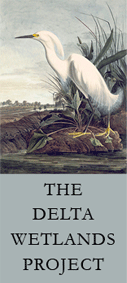A key location
The Delta Wetlands Project is located in the heart of the Sacramento-San Joaquin Delta. The Delta is part of an interconnected system of waterways, islands and sloughs that includes the Suisun Marsh and the confluence of the Sacramento and San Joaquin rivers. The Delta, encompassing more than 700,000 acres, is the largest estuary on the Pacific Coast and serves as one of California's most important water sources. From a water supply standpoint, the Delta Wetlands Project is ideally located downstream of California's largest watersheds and in close proximity to existing state and federal pumps. The reservoirs can fill rapidly with freshwater flows into the Delta and can later release the water for a variety of beneficial purposes. Released water will reach state and federal export facilities or be used for Delta outflow – in a matter of hours – making the project an extraordinarily responsive real-time water supply and environmental management asset. The water stored on the islands can be used for a variety of purposes, including domestic, municipal, industrial and agricultural use, as well as fish and wildlife preservation and enhancement.
Many studies have been conducted.
Consistent with long-term vision for a sustainable Delta
The Delta Wetlands Project is consistent with State's co-equal goals for the Delta, including protection, restoration, and enhancement of the Delta ecosystem and a more reliable water supply for California. The project also provides a significant investment in Delta sustainability through major levee improvements to strengthen 56 miles of Delta levees. It all but eliminates subsidence on 20,000 acres of Delta lowlands and provides 9,000 acres of new wetland and wildlife habitat. The project can also be operated as an emergency response tool to reduce salinity intrusion should other Delta islands breach. The project is also consistent with the Bay Delta Conservation Plan (BDCP), including restoration of tidal marsh in the western Delta, enhancement of channel margin habitats, restoration of riparian and scrub habitat, reduction in agricultural pesticides/herbicides entering Delta waterways, improving discharged water quality from Delta islands, and screening Delta diversions to reduce fishery entrainment.

